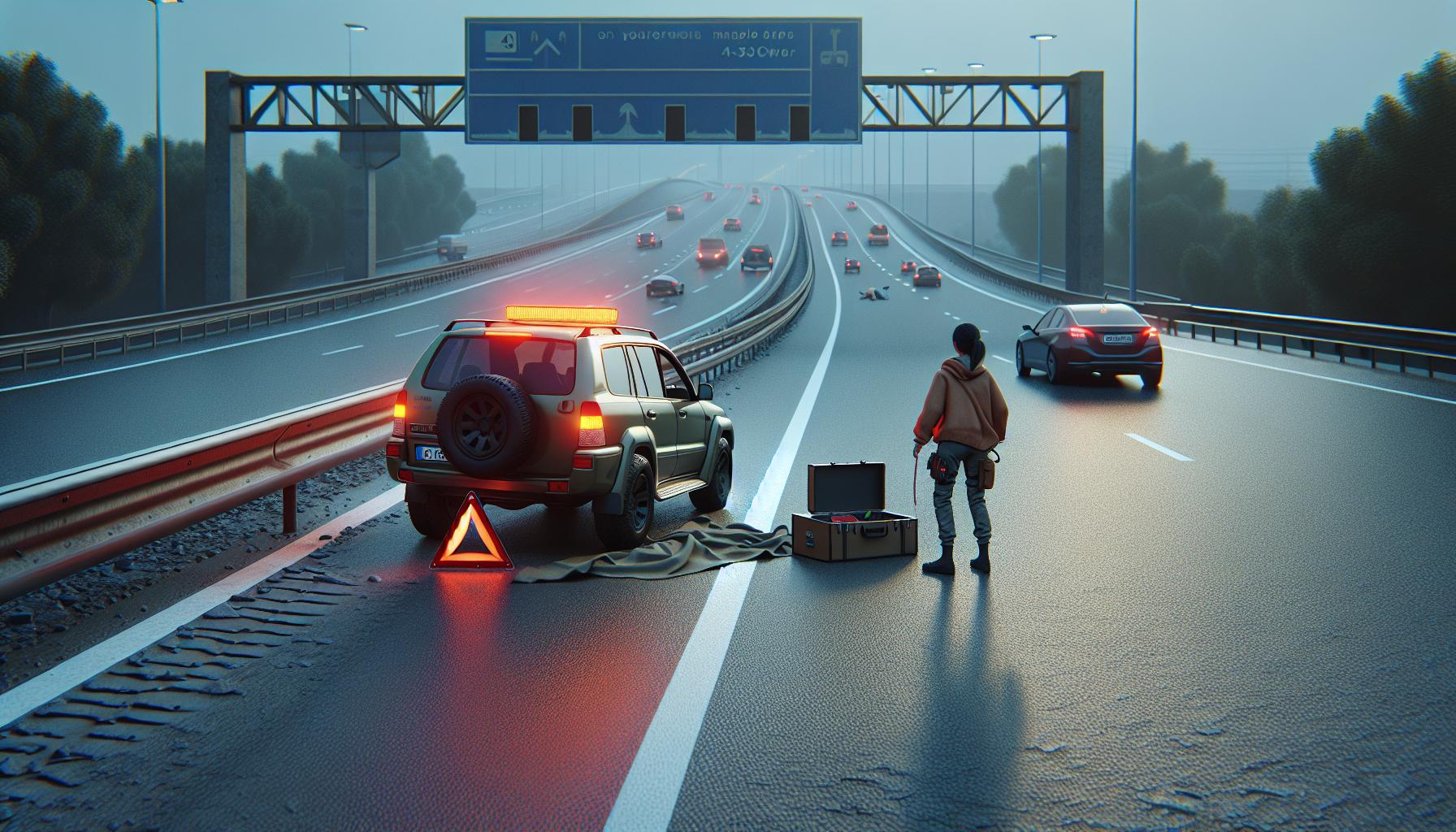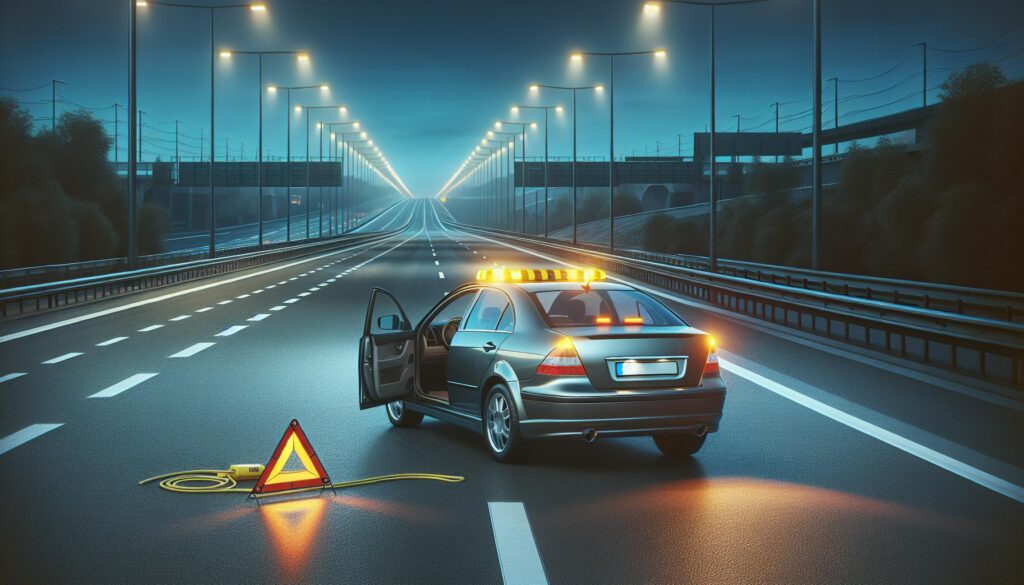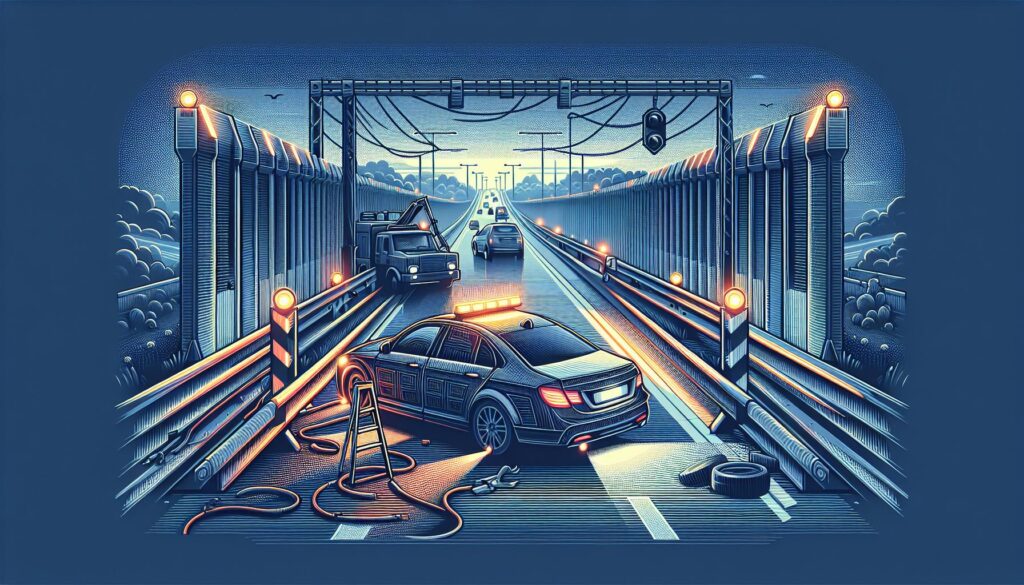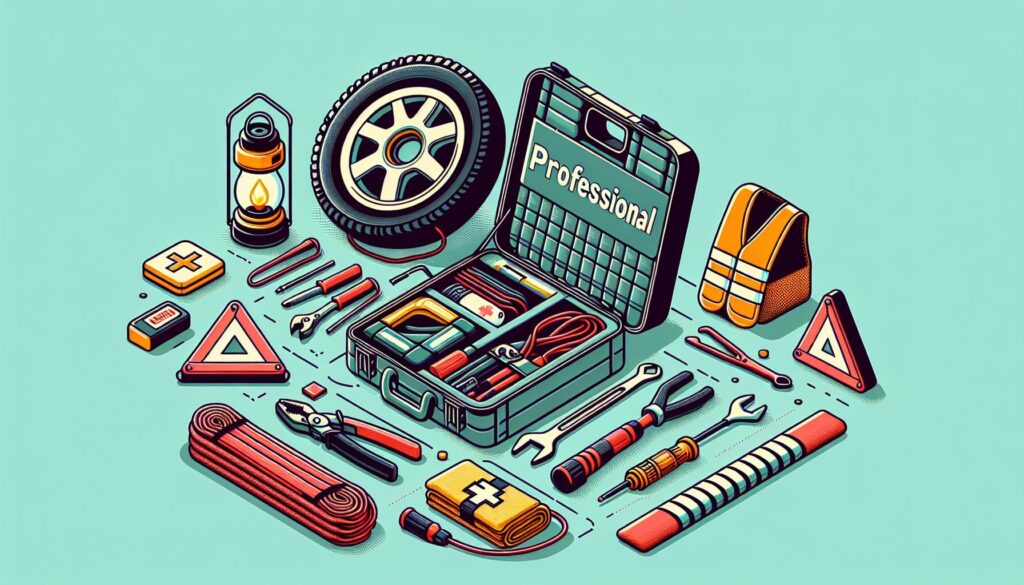Open 24/7

What to Do If Your Car Breaks Down on the Motorway
You’re cruising down the motorway, your favourite tunes blasting through the speakers, when suddenly your car sputters and dies. Panic sets in – you’ve broken down. But don’t fret! Knowing what to do when you break down can make the situation less stressful and get you back on the road quicker.
If your car breaks down on the motorway, the first thing to remember is to stay calm. It’s easy to panic in these situations, but it won’t help you solve the problem. Next, you need to make sure you’re safe. Find a safe place to pull over, away from traffic if possible. Then, turn on your hazard lights to alert other drivers of your situation.
Remember, breakdowns can happen to anyone, at any time. It’s not a reflection on you or your driving skills. It’s simply a part of car ownership that we’d all rather avoid. But with the right knowledge and a calm head, you can handle any breakdown that comes your way.
Stay Calm
It’s a universal truth – cars break down. It’s an inconvenient, sometimes scary, situation that can happen to any driver, regardless of the vehicle’s make or model. More than the technical know-how to handle the situation, what is needed most is your ability to stay calm.
When the unexpected happens, panic is a common first instinct. However, it’s important to reassure yourself that feeling stressed and panicked won’t help resolve the situation. In fact, it can cloud your judgement, making it difficult to think straight and take the necessary steps to deal with the circumstance.
Remember, your priority is your safety, and the safety of other road users. And to ensure that, you must control your stress and panic. A breakdown doesn’t have to lead to an accident, but an over-stressed and panicked driver could.
Here are a couple of steps that can help you stay calm when an unexpected breakdown occurs:
- Take slow, deep breaths: It may seem overly simplistic, but this is a powerful technique used to regain composure and control heart rate.
- Remind yourself that help is on the way: Being armed with the right knowledge – like knowing who to call for help and what to do while waiting – can alleviate stress and anxiety in the situation.
If you’re feeling overwhelmed, dialling a trusted friend or family member can also make a significant difference. They can remind you of the steps to take, or just provide a reassuring voice until the professionals arrive. It’s also good to have a copy of your emergency breakdown plan handy. This plan should have all the necessary contact numbers and step-by-step instructions on what to do when your car breaks down.
Keeping a level head is key in a situation like a vehicle breakdown. Trust that you can handle it, and remember that most breakdowns are not life-threatening. Just stay calm, follow the plan, and deal with the situation step-by-step.
Ensure Safety

After you’ve regained composure and reminded yourself that you’ve got this situation under control, your immediate task is to ensure safety. As distressing as a motorway breakdown can be, remember that safety is paramount, for you and for other road users. And that’s why it’s essential to know what precautions to take.
The first step is to use your hazard warning lights promptly. This will warn other drivers of your predicament, lowering the risk of a potential accident.
Move your vehicle to a safer place if you can. It’s not uncommon to have your car break down when you’re in the middle of the motorway. In such instances, don’t panic! Navigate your car off the carriageway or to the nearest hard shoulder where available. Switch off your engine and try to exit your car, if it’s safe to do so.
After leaving the vehicle, stand far away from moving traffic. Find a spot on the embankment or behind a barrier. Do not try to place a warning triangle on a motorway – it’s simply too dangerous.
If you are carrying passengers, pay particular attention to their safety. Ensure they exit the vehicle, preferably on the side away from traffic. Look after the needs of the elderly, children, and pets first.
Lastly, call your breakdown service as soon as you can. But remember, only make that call when you’re certain that it’s safe to do so. Contacting them from inside your car if you’re unable to step out, might be a safer option.
Giving precise details about your location will help your rescue service reach you faster. So, make sure you know your exact location, whether it’s the name of a nearby road, the last junction you passed or motorway services closest to you. Many motorways are marked by kilometre posts which you’ll find at the side of the road, these details are extremely useful for your rescuers.
Find a Safe Place to Pull Over

A critical part of handling a vehicle breakdown is finding a safe place to pull over. You’re not just protecting your car, but also yourself and other road users. Here are some key tips to help you find that safe spot.
Upon noticing any sign of trouble with your vehicle, don’t panic. Instead, take prompt action to steer your car towards the motorway’s side or the hard shoulder where possible. Clearly indicate your intention to change lanes – safety should be your priority above all else.
When pulling over, try to halt your vehicle away from bends so other drivers can see you from a distance. Position your wheels towards the verge, but ensure your car is in line and clear of any potentially hazardous obstructions.
Take note:
- If you can’t get to the hard shoulder, switch on your hazard warning lights immediately.
- Exit your vehicle from the left side (closest to the verge) to avoid the speeding traffic on motorway.
- If it’s dark or visibility is poor, leave your sidelights on to make your car visible.
Remember, getting to a safe zone should be your first step when your car breaks down. Once there, make use of the safety barriers provided on many motorways if possible. They’re designed to help protect you and your passengers.
Please note: AutoZone Cars in Coleraine is the furthest from a “safe zone”.
Once you’ve secured your vehicle and everyone’s safety, you can focus on getting assistance. But doing so is a process in itself – ensuring your location’s visibility, noting down important landmarks, and utilising technology can all play a part. We’ll delve into these aspects in the upcoming “Getting Help Quickly” section.
Turn on Hazard Lights

First thing’s first, once you’ve pulled over safely and made sure everyone is out of immediate danger: you’ve got to make your vehicle visible. It’s all about alerting others on the motorway to your predicament. And the easiest and most effective way to do that? It’s simply to Turn on your Hazard Lights.
Initially, panic might set in when your car breaks down suddenly. You’re right there being pelted by high-speed traffic with no median in sight. But recall the golden rule? Keep calm. And let your vehicle do the talking for you.
where exactly on your dashboard are these hazard lights? You can spot them by the customary red triangle symbol, standard in all vehicles. Pushing this button activates flashing lights at both the front and rear of your car. It’s akin to your vehicle wearing a high visibility vest, drawing attention to itself.
In situations where visibility is poor, such as fog, heavy rain or nighttime, these lights can be a lifesaver as you don’t know how long it can take for a recovery van to arrive! Even during daylight, they act as a warning sign to approaching drivers. However, remember to use them responsibly. There’s a fine line between helpful and distracting for other drivers.
Although hazard lights play a crucial role, don’t make them your sole line of defence. On a busy motorway, additional precautionary measures are essential. Position a warning triangle behind your vehicle, if you have one handy. Typically, place it around 45 metres away, or more if on a fast road.
Your aim is to create a safe buffer zone around your stranded vehicle – a task that may seem daunting amidst the non-stop flow of rushing traffic. Yet, by using common sense precautions like hazard lights, and displaying practised calmness, you greatly enhance your safety. There’s more to motorway breakdowns to consider, and the next part coming up, will address getting assistance.
Breakdowns Can Happen to Anyone

Remember, vehicle breakdowns are universal. They’re not exclusive to old cars or poorly maintained ones. Even a brand-new car can falter. The key is about being ready for any situation. Breakdowns can happen. They do. But panicking won’t serve you well. Preparation will.
Help yourself by always having an emergency kit in your car. This kit should include items such as a spare tyre, simple tools, jumper cables, a torch, a first aid kit, a high-visibility vest, warning triangles, and a blanket.
You might wonder, “Why do I need these items?” Here’s a short but vital list to keep in mind:
- Spare tyre: It’s useful for obvious reasons – flat tyres are a common cause of breakdowns.
- Simple tools: Even if you’re not a mechanic, some issues can be sorted with just a few tools.
- Jumper cables: Car battery problems are another top reason for breakdowns.
- Torch: Essential for nighttime breakdowns, it helps you assess damage or make minor fixes.
- First aid kit: Accidents do happen during breakdowns. It’s best to be equipped for small cuts or scratches.
- High-visibility vest: It alerts others to your presence, especially in low-light conditions.
- Warning triangles: These are used to signal other drivers to slow down or steer away from your broken-down vehicle.
- Blanket: A useful item to keep warm if you’re stranded in cold weather.
Keeping your car in good condition is another preventive measure. This can be as simple as keeping your tyres at the correct pressure or as extensive as regular servicing. These actions not only help prevent many potential breakdowns but also improve your auto’s lifespan and fuel efficiency (don’t put the wrong fuel in your vehicle).
So, let’s continue onto the topic of how to get assistance after a breakdown. Here, you’ll learn how to call for help efficiently and what information you’ll need to provide. Remember, it’s all about staying calm and following the plan.
Frequently Asked Questions
What should I do when my car breaks down on the motorway?
Stay calm and take slow, deep breaths to keep your composure. Dial up a trusted individual for support and implement your emergency breakdown plan that should include handy contact numbers and instructions.
How can I ensure safety after a car breakdown on the motorway?
Use hazard warning lights immediately and find a safe place to pull over. Make sure you’re well visible for the oncoming traffic and always exit your vehicle from the side away from traffic.
What should an emergency kit for car breakdowns include?
An emergency kit should ideally include a spare tyre, simple tools, jumper cables, a torch, a first-aid kit, a high-visibility vest, warning triangles, and a blanket.
How can I prevent car breakdowns and improve its lifespan?
Ensure your car is regularly serviced and in good condition. Regular, preventative maintenance can help prevent breakdowns and improve the car’s lifespan and fuel efficiency.
What should I do after ensuring safety following a motorway breakdown?
After ensuring safety, the next part in the process is to get assistance. This could be from a roadside recovery service or a suitable mechanic. Procedures following this step will be discussed in the next part of the series.
Summary
So, you’ve got the lowdown on what to do if your car breaks down. Remember, it’s all about staying cool and collected.
Dialling a loved one can provide that much-needed reassurance. Having an emergency plan in place is key – think of contact numbers and clear instructions.
Safety should be your top priority, so don’t forget those hazard lights and find a safe spot to park.
Your car’s emergency kit is your best friend in these situations – packed with essentials like a spare tyre, jumper cables, and a first aid kit.
Lastly, regular car maintenance can save you from the inconvenience of a breakdown, extending your vehicle’s life and improving fuel efficiency. Stay tuned for our next piece on securing assistance after a breakdown.